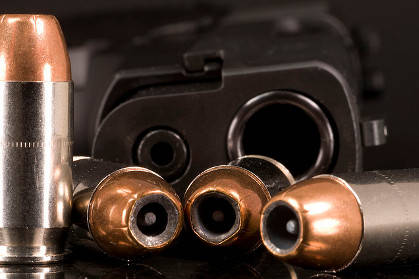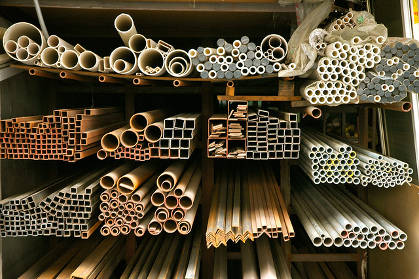Original URL: https://www.theregister.com/2014/11/06/3d_printed_guns_analysis/
3D printed guns: This time it's for real! Oh, wait – no, still crap
It turns out you can make a real gun ... from steel and gun parts
Posted in Personal Tech, 6th November 2014 12:01 GMT
So, hype notwithstanding, it's now pretty well acknowledged that you cannot in fact make a useful gun out of plastic in a consumer-grade 3D printer.
But wait! Hold everything! There's a new "Bullet That Could Make 3-D Printed Guns Practical Deadly Weapons"! Holy Cow!
Oh dear.
The ".314 Atlas" from designer Michael Crumling is not a bullet, which is the projectile which comes out of a gun. It is what's known – outside the US "technology" media, anyway – as a cartridge. A normal cartridge consists of a cylindrical case, typically made of thin brass, which holds the propellant powder that will burn to generate the hot gas which will push the bullet down the gun barrel.

Pistol cartridges (the protruding, copper-coloured bit is the bullet) and a pistol... By "Ken", licensed under CC 2.0
The bullet itself is fitted into the open end of the cartridge case. The closed base of the case holds a primer – a cap – which will ignite when struck by the firing pin, setting off the powder to fire a shot.
A normal brass cartridge doesn't have the strength to contain the expanding powder gases: it doesn't need to as it is slotted into the gun's steel chamber with its bullet poking into the barrel itself. The brass case merely provides what's called "obturation" – it expands under the gases' pressure and seals tightly to the chamber sides, preventing any gas from leaking back out of the chamber.
The cartridge doesn't simply shoot backwards out of the chamber because its base is held firmly in the chamber by one sort of robust metal mechanism or another, depending on the firearm.
All this means that the hot powder gases have nowhere to go, and thus they ram the tightly fitting bullet with tremendous force along the barrel, even though the barrel's rifling is such a tight fit that it is actually cutting into the bullet as it goes, imparting the powerful spin that will make the bullet fly straight.
The tight barrel fit means that the expanding gases cannot leak past the bullet and thus they impart a lot of their energy to the projectile. It also means that the barrel must be strong too, to resist the high gas pressures generated inside it.
Pretty much none of this can work in a gun made of 3D printed plastic. The chamber cannot be strong enough, the barrel cannot be strong or tight enough, and the mechanism holding the cartridge base in place cannot be robust enough. That's why 3D printed guns are crap.
Violent recoil
The "Atlas .314" attempts to solve this problem by including a steel barrel and chamber as part of the cartridge. Instead of being attached to the cartridge tip, the bullet in the Atlas is recessed well down inside the heavy tubular steel case. There is a notional plastic barrel in Crumling's accompanying 3D-printed "gun" as well, with pretend rifling to comply with US gun law, but it is the steel tube of the Atlas which does the work; the "gun" has become nothing more than a holder with a striker mechanism for popping the cap (and indeed Crumling's striker mechanism is actually made of proper steel gun parts).

GUN BARRELS: Actually, almost any metal tube can contain an explosion
The one problem that hasn't been addressed here is that of stopping the cartridge from recoiling violently backwards on firing, and sure enough it turns out that the original "gun" design shattered itself attempting to do this. Crumling has "solved" this issue by simply removing the top and back of the "gun" and allowing the heavy steel case to fly out to the rear on firing. This works just fine when shooting the "gun" on a test stand with a string to the trigger, but would not be very practical if one were actually holding the thing.
Of course the Atlas cartridges, being made of steel rather than crappy laminated plastic, cannot be 3D printed at home. Crumling makes them using a lathe — a machine tool. Ignorant journalists are excited by the fact that once fired the cartridges can be refilled with powder, fitted with a fresh primer and a new bullet, and used again: but this is also true of normal spent brass. Thrifty gun fanciers have been recycling their cartridge cases time out of mind.
So — amazingly — it turns out yet again that with nothing more than machine tools, steel and some specialist manufactured parts YOU CAN MAKE A GUN. As indeed you have always been able to. If like Mr Crumling you insist on using 3D-printed plastic for one of the important functions, it will be a crappy and dangerous gun: Crumling's .314 Atlas weapon will lack striking power, range and accuracy compared with a proper gun with a proper rifled barrel and breech mechanism, and will badly injure anyone foolish enough to be behind it when it goes off.
But it's hard to see why you'd bother fooling around with a 3D printer when you have steel, gun parts and proper tools: why not just finish the job and make a proper gun?
You wouldn't get breathlessly written up in WiReD, of course. That publication gaspingly tells us:
Crumling’s 3-D printing-friendly ammo will serve as a proof-of-concept, and a reminder: If gun control advocates are taking comfort in printed weapons’ impracticality, that comfort gets a little colder with every upgrade.
Rubbish: nothing has changed here. Plastic 3D printing remains a stupid and impractical way to make any important part of a gun, and it has always been possible to make a gun with the right materials, tools and parts — guns are actually relatively simple machines.
And it's always been very hard to see why an American gun-control advocate would care a jot about 3D printing or indeed any form of home gunsmithing, when it remains completely legal for a US citizen to go out and simply buy a real proper gun made in a factory, in many cases without so much as a criminal records check let alone any form of licencing or registration.
Against that unchanging background, it would be very difficult to overstate the unimportance of Mr Crumling's invention. ®
Those interested can read Lewis Page's gun CV at the bottom of this article.